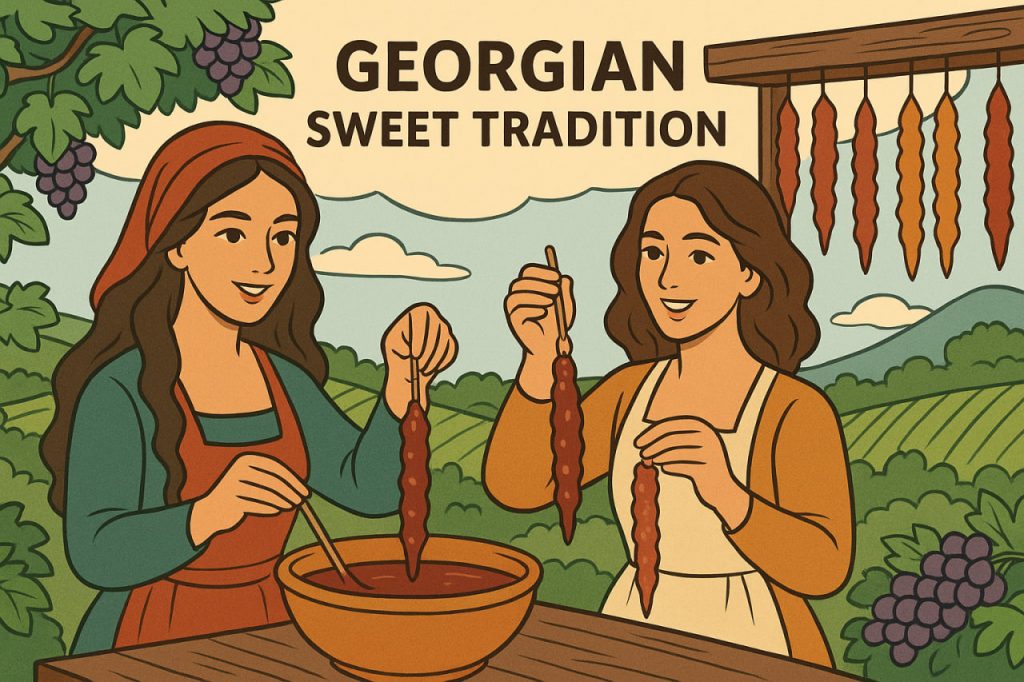Churchkhela is a traditional Georgian delicacy often described as a natural candy filled with rich flavor and history. This delicious treat has been cherished for centuries, especially among travelers and warriors, because it provides long-lasting energy and can be stored for extended periods without spoiling. Made primarily from grape juice, nuts, and flour, Churchkhela reflects the essence of Georgian culture, where food is both nourishment and an expression of tradition. It is often seen hanging in local markets across Georgia, resembling colorful wax candles that attract tourists and locals alike.
The Origins and Cultural Significance of Churchkhela
Churchkhela’s roots trace back to ancient Georgia, where winemaking and grape harvesting were central to the economy and lifestyle. The creation of this sweet snack was a way to preserve the energy and nutrients of grapes and nuts during long winters or travels. According to historians, Georgian warriors carried Churchkhela during campaigns because of its high caloric value and durability. It was considered a symbol of abundance and good fortune, often served during festivals or family gatherings. Over time, Churchkhela became more than a food—it became an integral part of Georgian identity and hospitality.
How Churchkhela Is Made
The process of making Churchkhela is both artistic and practical. It starts with freshly pressed grape juice, which is boiled and thickened with flour to create a rich, pudding-like mixture called tatara. Stringed nuts, typically walnuts, hazelnuts, or almonds, are then dipped repeatedly into the mixture until they are fully coated. Afterward, they are hung to dry in a cool, shaded place for several weeks until the outer layer hardens into a chewy texture. The result is a nutritious and naturally sweet snack without artificial ingredients. Many Georgians still prepare Churchkhela by hand, passing recipes from one generation to another.
Nutritional Value and Health Aspects
Churchkhela is not just a traditional dessert—it is also a powerful source of energy. The natural sugars from grape juice combined with the proteins and healthy fats from nuts make it a balanced, nutrient-rich snack. It is often compared to modern energy bars because it provides sustained energy without processed sugars. According to Dr. Nino Mikadze, a Georgian nutrition expert, “Churchkhela offers a unique balance of carbohydrates and antioxidants, making it an excellent natural alternative for athletes or anyone seeking a healthy energy boost.” However, as with any sweet treat, moderation is key.
Modern Adaptations and Global Popularity
Today, Churchkhela has crossed Georgian borders and gained recognition worldwide. Tourists visiting Georgia often take it home as a culinary souvenir, while international markets increasingly import it as part of gourmet collections. Modern confectioners experiment with different flavors, adding pomegranate juice or various nuts to suit diverse tastes. Food historian David Kandelaki notes that “the global rise of interest in traditional, organic snacks has put Churchkhela in the spotlight as a healthy heritage product.” Despite these innovations, authentic Churchkhela remains deeply connected to its Georgian roots and continues to represent the spirit of traditional craftsmanship.
Interesting Facts
- The word Churchkhela comes from the Georgian words meaning “string” and “nut shell.”
- Historically, it was sometimes referred to as “the Georgian Snickers” due to its energy-rich composition.
- In some Georgian regions, people dip the Churchkhela multiple times to make the outer layer thicker and chewier.
- It can stay fresh for up to a year if stored in a dry, cool place.
Glossary
- Tatara — A thick grape juice and flour mixture used to coat nuts when making Churchkhela.
- Antioxidants — Natural compounds that help protect the body from cell damage.
- Caloric value — The amount of energy provided by a food, measured in calories.
- Organic snacks — Foods made without synthetic chemicals, pesticides, or artificial additives.


